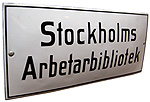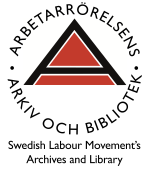Our history based on the most important years, from the founding of the institution until today.
More detailed descriptions of our history are found in Arbetarrörelsens arkiv tjugo år (1923), Hävd och handling (1952), Arbetarhistoria nr 63-65 (90 år), Historia som uppdrag (pdf) (100 år).
1902
 The Swedish Labour Movement’s Archives and Library was founded as a part of the Stockholm’s Workers’ Library and was the first labour movement archive in the world. The archival material of the labour movement was early on intended to be preserved for the future and an extensive collection work was launched. The initiator was Oscar Fredrik Borge (21/1 1862 – 4/1 1938), engaged in the labour movement and working at the Stockholm Labour Library – at the same time holding a PhD in biology with freshwater salmon as a speciality.
The Swedish Labour Movement’s Archives and Library was founded as a part of the Stockholm’s Workers’ Library and was the first labour movement archive in the world. The archival material of the labour movement was early on intended to be preserved for the future and an extensive collection work was launched. The initiator was Oscar Fredrik Borge (21/1 1862 – 4/1 1938), engaged in the labour movement and working at the Stockholm Labour Library – at the same time holding a PhD in biology with freshwater salmon as a speciality.
1903
The archive was officially opened for the public on November 1, and in the beginning consisted only of one small room in the Labour Library in The People’s House, at Barnhusgatan 14, 1st floor, in Stockholm. Oscar Borge was officially employed on November 22.
1906
The archive was transferred to the Trade Union Confederation of Sweden (Landsorganisationen i Sverige) and Social Democratic Party (SAP) in joint ownership on July 1. The statutes were approved on September 7 and state among other things that the task of the institution was “to collect and preserve all printed and written documents that in one way or another affect the Swedish labour movement, both its trade unions and its political branch, as well as the more important printed documents that concern the foreign labour movement.”
The archivist who manages the archive “shall keep it open to the public at specified times”.
1907
From January 1, the archive consisted of two rooms in the People’s House, Barnhusgatan 14, 4th floor.
1919
Oscar Borge was employed full time.
1927
Oscar Borge, who up until 1927, was the sole employee, got a co-worker: Ivar Dahlberg (as of December 1).
1930
The archive was moved to Upplandsgatan 2, where it was housed in two rooms in the bottom floor, and five rooms on the first floor.
1938
Oscar Borge died on January 4. Tage Lindbom was appointed the head of the archive on November 4, 28 years of age and Doctor of Political Science with the dissertation Den svenska fackföreningsrörelsens uppkomst och tidigare historia 1872-1900 (eng: The Swedish Trade Union Movement’s Origin and Past History 1872-1900).
1940
The archive moved to new and larger premises at Upplandsgatan 4. From this time, local labour movement as well as popular movement’s archives are started all around the country. Our institution contributed through organisational work for their formation. Today we only store, with rare exceptions, local material from areas outside of Stockholm.
1965
Åke Wedin was appointed as the new head of the institution as of August 1.
1966
The institution was reorganized and from July 1 became a foundation with the State, Trade Union Confederation and Social Democratic Party as co-trustees.
1967-1968
The Popular Movement’s archives were consolidated as Folkrörelsernas arkivförbund, whose secretariat until September 2004 was with us, and thereafter at ArkivCentrum, Örebro län.
1975
Lars Wessman was appointed as the new head of the institution as of December 1.
1977
The institution celebrated its 75th anniversary and moved into new premises at Upplandsgatan 5. The same year, we began publishing the journal Meddelande från Arbetarrörelsens arkiv och bibliotek – (Arbetarhistoria) (MARAB).
1980
We hosted the eleventh yearly conference of IALHI, which was being documented in Arbetarhistoria nr 16.
1981
Our Research Council was formed.
1984
The journal Meddelande från Arbetarrörelsens arkiv och bibliotek (MARAB) changed it’s name to Arbetarhistoria.
1988
The library began cataloging it’s collection in Libris, the Swedish National Catalogue.
1994
Rudolf Meidner Award for research on the history and of the trade union movement is inaugurated on June 23, when Professor Rudolf Meidner turned 80 years old.
1998
Karin Englund was appointed as the new head of the institution as of March 1.
The institution once again moved to new premises, back to Upplandsgatan 4, by this time with two floors of offices.
1999
The institution obtained a distant archive depot, in a former mining cabin in Grängesberg, Dalarna. The storage facility was manned with 1-2 persons.
2001
The library began to use the catalogue system Mikromarc.
2002
We celebrated our 100th anniversary by publishing three books: Klass i rörelse, Historia som uppdrag och Världen i källaren. We once again hosted the annual IALHI conference.
2005
Lars Ilshammar was appointed as the new head of the institution.
2007
The library abandoned the old card system and instead fully adopted the catalogue system integration circulation module.
2009
We began the process of introducing CALM as an archival registering system.
2012
The institution moved from the premises by Norra Bantorget, central Stockholm, to Flemingsberg.
2013
Lars Ilshammar ended his employment as head of the institution.
2014
Nina Sjöberg was appointed as the new head of the institution.
2015
The use of he Grängesberg depot was scheduled to be terminated by the end of 2015. All materials were moved to Flemingsberg, and the banners and standards were moved to the depot at Runö Folkhögskola, Åkersberga. Part of the materials stored at the Runö depot were moved to Flemingsberg.
2016
Nina Sjöberg ended her employment as head of the institution.
Mikael Eivergård was appointed as the new head of the institution.
2019
Mikael Eivergård ended his employment as head of the institution.
Monica Sparrman takes over as acting head of the institution.
2020
Håkan Nilsson was appointed as the new head of the institution.

